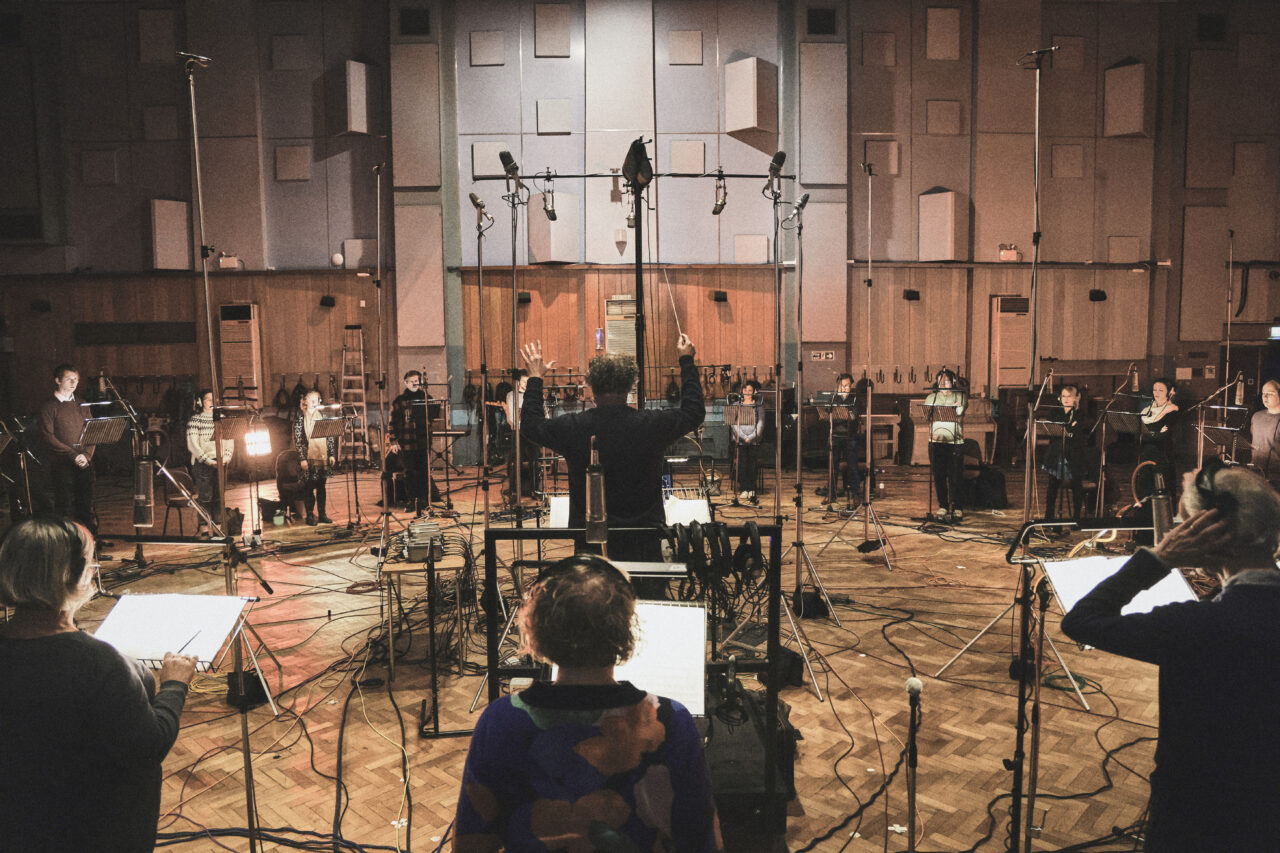“Breathtaking. I felt like I was on a journey through the galaxy at times. I feel grounded with a deep feeling of
happiness in my heart.” – Participant
Harmony of the Worlds sits at the intersection of the arts, science, education, wellness, and the environment. Supported by Arts Council England, the Hinduja Foundation, Luton Rising and the Mukhul Madhav Foundation, and a range of production partners, Harmony of the Worlds explores new creative paradigms through Deep Listening.
This process is developing fresh approaches to performance, recording and education whilst simultaneously exploring the therapeutic potential of sound and music.
A collaboration between Sound Artist and Composer Satya Hinduja and Conductor David Murphy, it is an immersive deep listening experience that combines spatial audio and vibroacoustic technology with live orchestra, choir, and ancient instruments from around the world.
The Premiere Harmony of the Worlds experience took place in January 2023 in St Mary’s Church, Luton
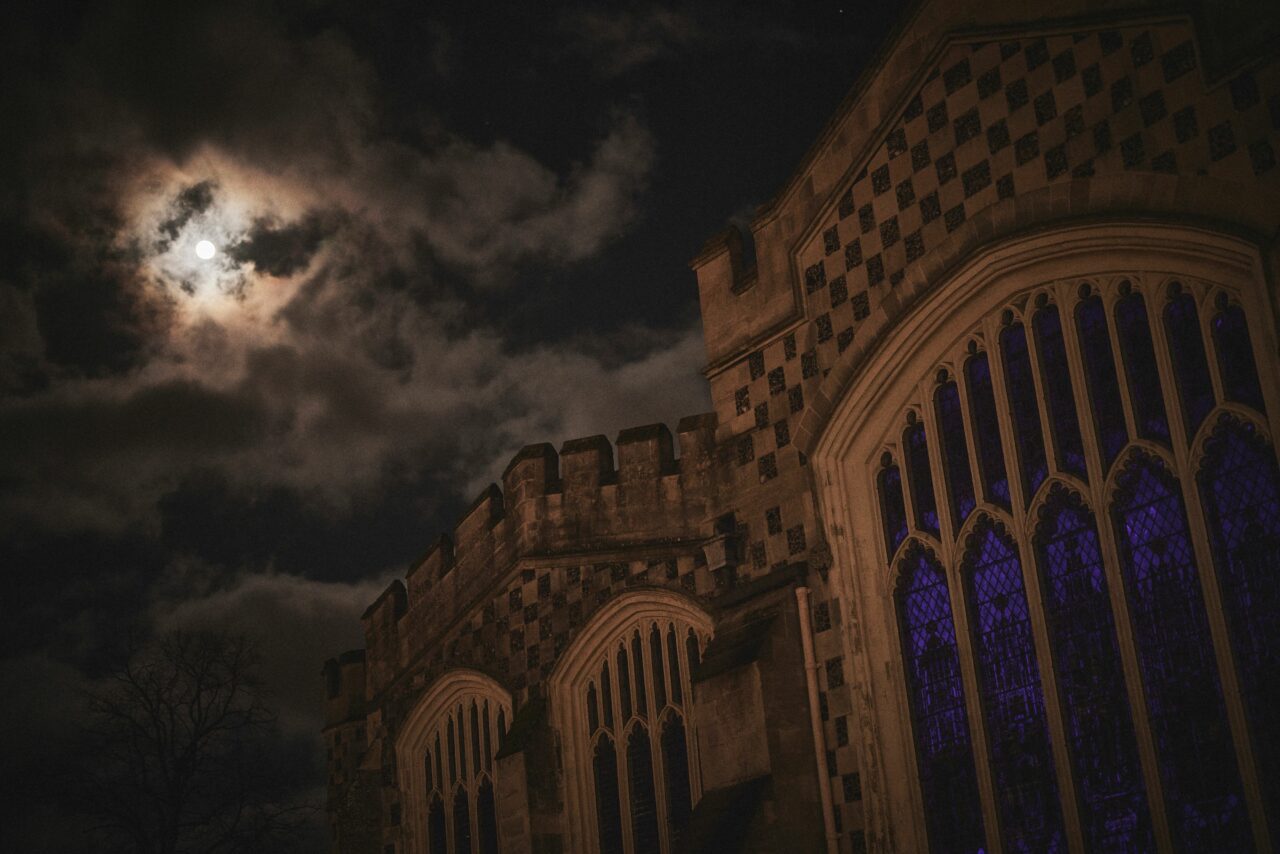
Image: St Mary’s Church, Luton immediately before the Premiere of Harmony of the Worlds. Photography: Anders Birger
Luton is an airport town with one of the UK’s youngest, most transient, most diverse demographics. St Mary’s Church is a beautiful, atmospheric, architecturally unique space dating back over 1000 years situated in the centre of town. As a vibrant place with both social challenges and huge creative potential, Luton was an ideal starting point for a creative journey encompassing performance, education, community outreach and social prescription.
PERFORMANCE
“Calm. At peace. Content. Warmth. Sense of humanity and a kinder world. I love the way Essence prepared us for Beethoven and I liked the sequence into the symphony. I loved the experience.” – Participant
Harmony of the Worlds juxtaposes the composition Essence – 136.10 Hz The Earth’s Primal Frequency with a contrasting work. This could be music, dance, literature, theatre, or visual art. The works shine a light on each other, with Essence serving to enhance the listener’s sensory awareness. Through focussing on the sense of hearing, Essence awakens a heightened perception and sense of presence in the listener.
This World Premiere of Harmony of the Worlds featured the following programme:
Essence I Symphony No. 6 Essence II
Satya Hinduja Ludwig van Beethoven Satya Hinduja
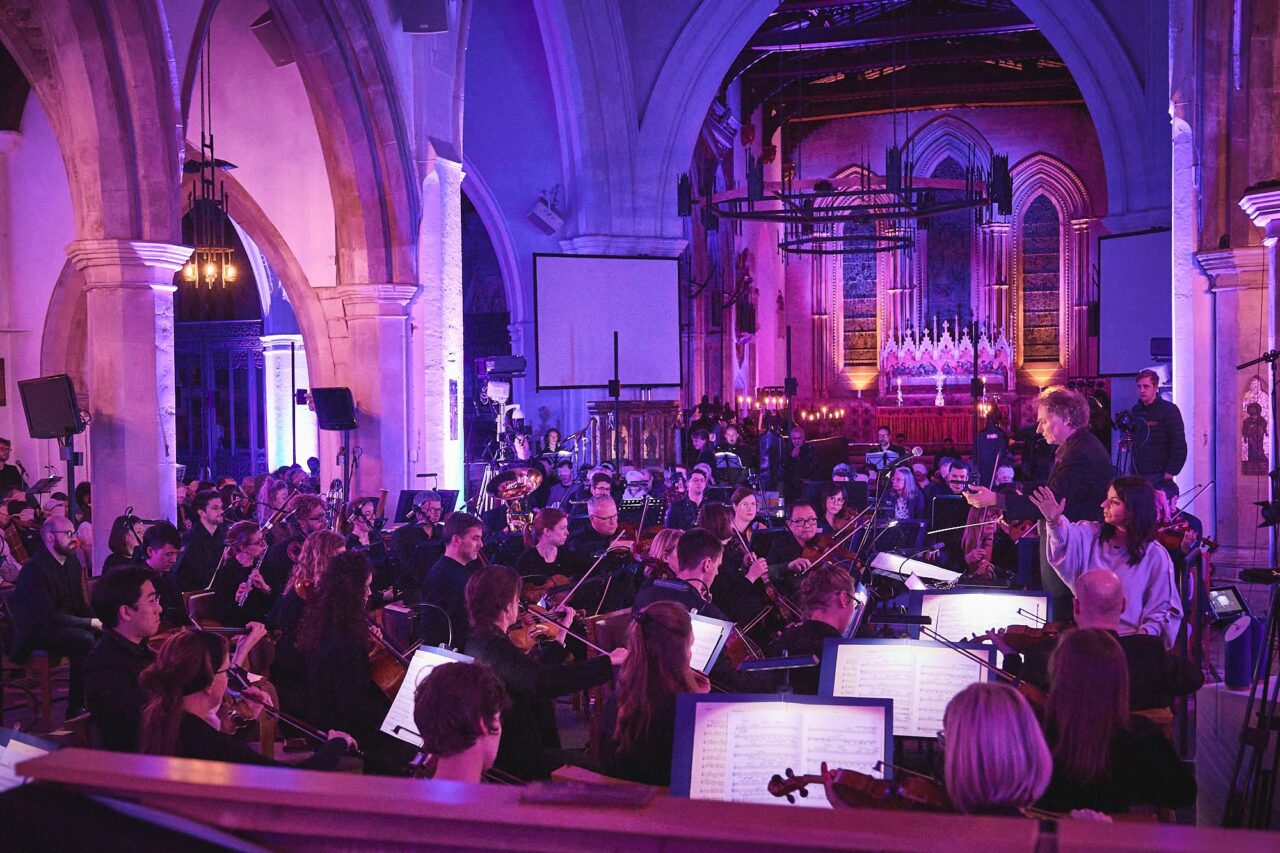
Image: Harmony of the Worlds Premiere. Photography: Anders Birger
Satya Hinduja and David Murphy collaborated with the Royal Philharmonic Orchestra and Synergy Vocals. Immersive audio and vibroacoustic technology were provided by tech partners d&b Audio and SubPac, with Mark Rogers directing the live sound.
Harmony of the Worlds was initiated by David Murphy’s exploration of Deep Listening and Satya Hinduja’s parallel project Alchemic Sonic Environment – a sound therapy initiative exploring the nature of health through multi-sensory deep listening experiences.
The project is inspired by the organic flow and interconnectivity of the natural world, and by the ‘overview effect’– a major shift in perspective that astronauts have reported on experiencing the beauty and fragility of our earth from space.
Harmony of the Worlds takes its name from the astronomer Johannes Kepler’s 1619 book Harmonices Mundi. In this work, Kepler catalogues the motions of planets in musical terms, taking his inspiration from Pythagoras’s concept of a universal music, the music of the spheres.

In bridging Satya Hinduja’s Essence: 136.10 Hz The Earth’s Primal Frequency with Beethoven’s ‘6th Symphony,’ Harmony of the Worlds continues a musical tradition straddling millennia whilst enabling listeners to encounter sound and music in a completely new way.

Image: Harmony of the Worlds Premiere. Photography: Anders Birger
Essence is based on the frequency 136.10 Hz which directly represents in sound ( via a transposition of 32 Octaves ) the annual journey of the Earth around the Sun. The rhythms of the seasons and therefore of all life on Earth spring from this frequency.
Essence is scored for orchestral instruments, voices, instruments from a variety of world music traditions, electronics, spatial sound, vibro-acoustics and emerging technologies. A pioneering work, it creates an experience that is a sonic interplay of distance and tactile proximity where the movement of, and improvisation with sound objects in space contributes to a unique sonic journey.
In the foundational iteration of Harmony of the Worlds, the listener, attuned by Essence to the frequencies of nature, continues their Alchemic Sonic journey with Beethoven’s Pastoral Symphony, the composer’s ecstatic contemplation of the natural world.
Beethoven’s Pastoral Symphony explores nature’s capacity to heal alongside her capacity to impact dramatically in the lives of human beings – an environmental message especially relevant for our times.
Essence then returns to complete the Harmony of the Worlds experience, allowing the Earth’s Primal Frequency to tune us to our ourselves, to each other and to the planet.
‘It took me to a different space. I forgot about everything for the whole experience. It was extraordinary. I also felt a weight + pressing on my body. Very interesting and strange at the same time. A transcendental experience.’ – Participant
Research and Development:
During the height of the Covid pandemic, the Royal Philharmonic Orchestra opened a dialogue with David Murphy regarding new ways of connecting with audiences. The seeds of Harmony of the Worlds were planted at this point, resulting in a series of virtual experiences and workshops for RPO musicians in March 2021. These workshops explored two key pillars of the project: deep listening and creating improvised music based on environmental frequencies and ratios: music which is literally in tune with nature.

Image: Initial Zoom Workshop with Satya Hinduja, David Murphy and RPO Musicians. Photography: David Murphy
These workshops were very successful, and a decision was made to take the process to the next stage and manifest a live project with the orchestra.
In the months prior to the Harmony of the Worlds Premiere, RPO musicians, Synergy Vocalists, d&b Audio and SubPac Technologists, Satya Hinduja and David Murphy worked intensively to develop the theoretical and technical elements of the project, including a 5-day residency at BalletBoyz Studios, Kingston-Upon-Thames, UK during December 2022.

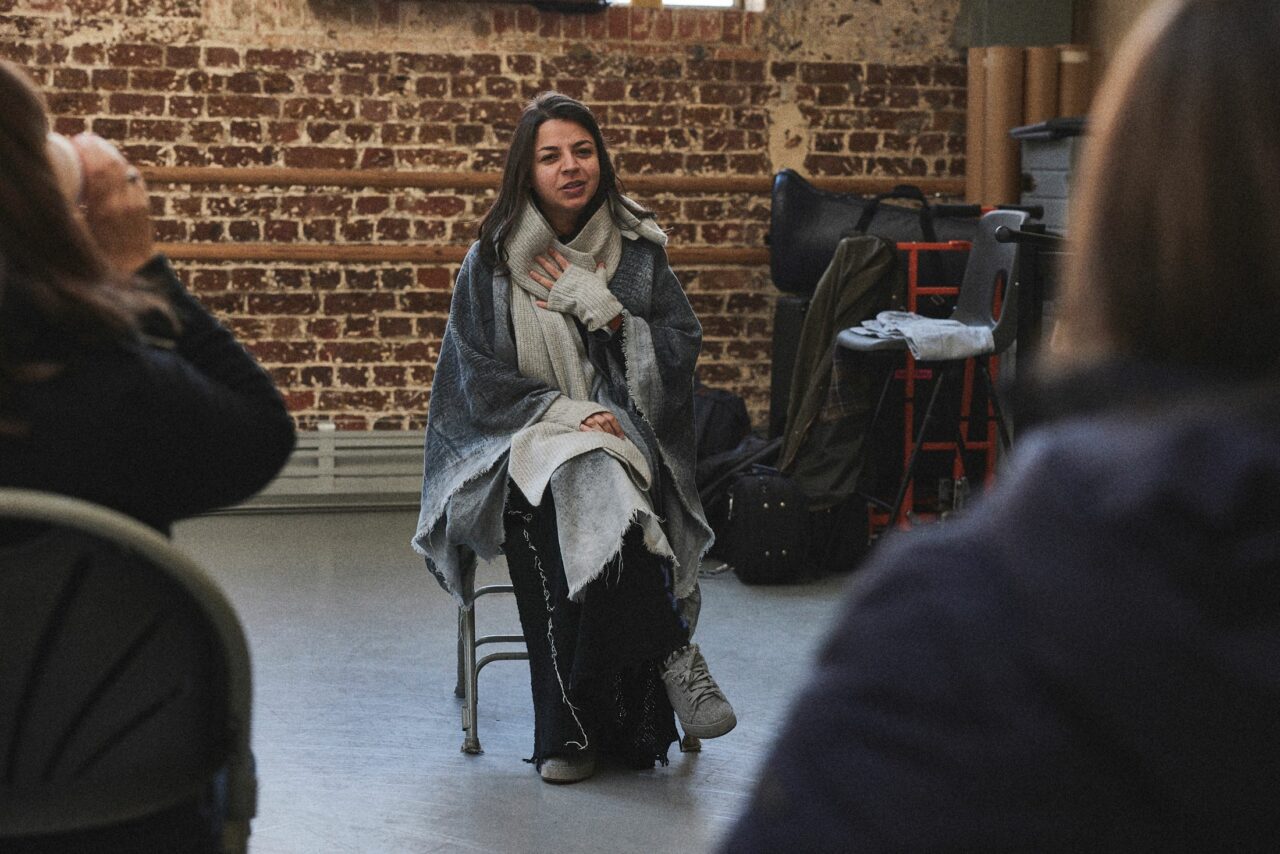
Images: Harmony of the Worlds Research and Development. Photography: Anders Birger
Education:
During the Autumn Term 2022, David, Satya, and a group of RPO Musicians worked with Luton Schools to explore deep listening in an educational context. In these schools, over 50% of the pupils are from Indian, Pakistani and Bangladeshi heritages, there is a large Roma community and English is a second language for over 90% of pupils. Listening is therefore an essential skill for these young people.
With the perspectives of these communities feeding directly into the artistic and educational process, Luton’s abundant cultural diversity and younger than average demographic inspired a highly creative education project.

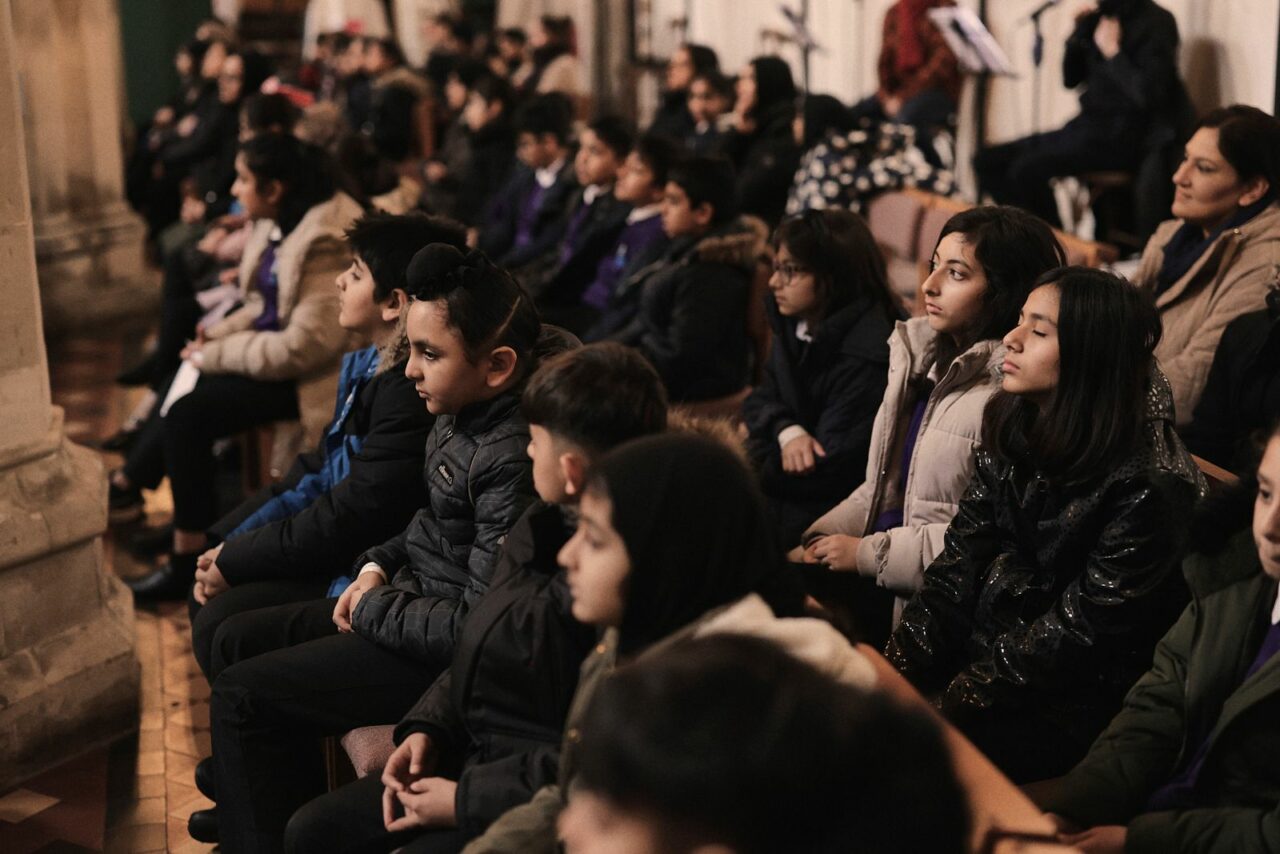
Images: Harmony of the Worlds Education Project – Final Sessions at St Mary’s Church. Photography: Anders Birger
“One of my best days ever”. (Year 5 Student, Bushmead Primary School, Luton).
Harmony of the Worlds uses sound and music as a metaphor for a more cohesive society, a place where communities can deeply listen to each other whilst sensitively interacting within a safe sonic space.
The project’s overarching creative concepts of awe, flow and connecting to each other and to the environment through sound facilitated this process; positive psychological states transcended barriers whilst creative flow dissolved them.
“The Earth Noise was satisfying” (Year 5 Student, Downside Primary School, Luton).
We worked with pupils from Downside Primary School, Bushmead Primary School, Challney High School for Boys, and Luton Sixth Form College in workshops exploring the project’s innovative approach to cross-curricular learning. This exchange led to the young people contributing creatively to the project through field recordings and artistic ideas to create a unique spatial audio composition combining the many voices and languages of Luton.

Image: Harmony of the Worlds Education Project. Photography: Nadia Rutgers
“I thought the piece with our voices was really funny and interesting. It reminded me of all the cultures our schools have and how unique we all are” (Year 5 Student, Downside Primary School, Luton).

Image: Harmony of the Worlds Education Project. Photography: Anders Birger
Students visited St. Mary’s Church in January to experience a deep listening workshop followed by the Royal Philharmonic Orchestra, Synergy Vocals and d&b audio exploring these ideas through music. For the vast majority of students, this was the first time they had heard a live orchestra.
“They were cool sounds and the orchestra was brilliant. I loved the double bass” (Year 5 Student, Downside Primary School, Luton).
Harmony of the Worlds acted as a cultural sounding-board, an acoustic mirror designed to enable all participants to deeply experience, reflect on, and then create new sonic art from sounds from their birth culture whilst creatively interacting with sounds from the other cultures that make up the rich diversity of their community.
Research shows that deeply listening to another’s sound – this could be the sound of the speaking or singing voice or a culturally specific sound – creates empathy. Empathy is a key factor in community cohesion.
Additionally, the project explored the potential of sound and music to create positive mental states in the classroom. One of the key findings of our schools’ workshops was the capacity of sound to create feelings of tranquillity and focus. We wanted to explore this further, and so returned to Downside Primary School, Luton in June 2023 to conduct some targeted experiments. The aim was to see if it was possible to quantify cognitive change after deep listening to music – specifically to Essence the work at the centre of this project. Over 175 children took part in the experiment, with initial results showing a marked improvement in test scores (12%) after listening.
“The orchestra and Earth sounds were excellent and amazing. I liked when the lady was holding that instrument and amazed when the sound turned into seawater” (Year 5 Student, Downside Primary School, Luton).
Sound as Therapy:
“The Earth sound and the orchestra was great and beautiful” (Year 5 Student, Downside Primary School, Luton).
The therapeutic potential of the project is especially exciting. Our experience of sound and music begins in our mother’s womb and has been shown to be integral to our brain development at this most formative stage. It is therefore no surprise that, later in the life cycle, music is shown to be an effective intervention for people suffering Alzheimer’s and Parkinson’s diseases. This is due to the enhanced connectivity within the brain facilitated by musical experience. With its emphasis on the emerging technologies of spatial sound and vibro-acoustics, new work created and inspired by this project has the potential to develop the role of music as a tool to promote brain health.
The intentional movement of ambient, drone and frequency-based sound objects in space, and their directional motion from the left ear to the right ear, from above & below and front to back with distance and proximity, are all components of spatial audio. Intentional music has been shown to reduce cortisol levels, activate hippocampal regeneration, calm the limbic system, heighten focus and awareness, generate brainwave entrainment and stimulate the vestibular system, thus enhancing neuroplasticity within the brain and our overall mental health and wellbeing. Spatial audio has even been shown to restore and maintain balance in cell organisms suggesting possible future applications for the treatment and prevention of disease and trauma. One theory is that spatial coherence of sound waves may improve homeostasis in the human body, leading to physiological and psychological benefits for the listener.
In addition to Alzheimers and Parkinsons diseases, scientific studies have also proven the benefit of music for Dementia, Autism, PTSD & Longevity. Binaural beats and bilateral music, which are the basis of spatial audio, have already been used by EMDR & Brainspotting therapists to facilitate trauma reprocessing through increasing the brain’s functional connectivity. Harmony of the Worlds poses a question to policymakers – What could we find if we go to the next level and integrate spatial audio within our healthcare systems?
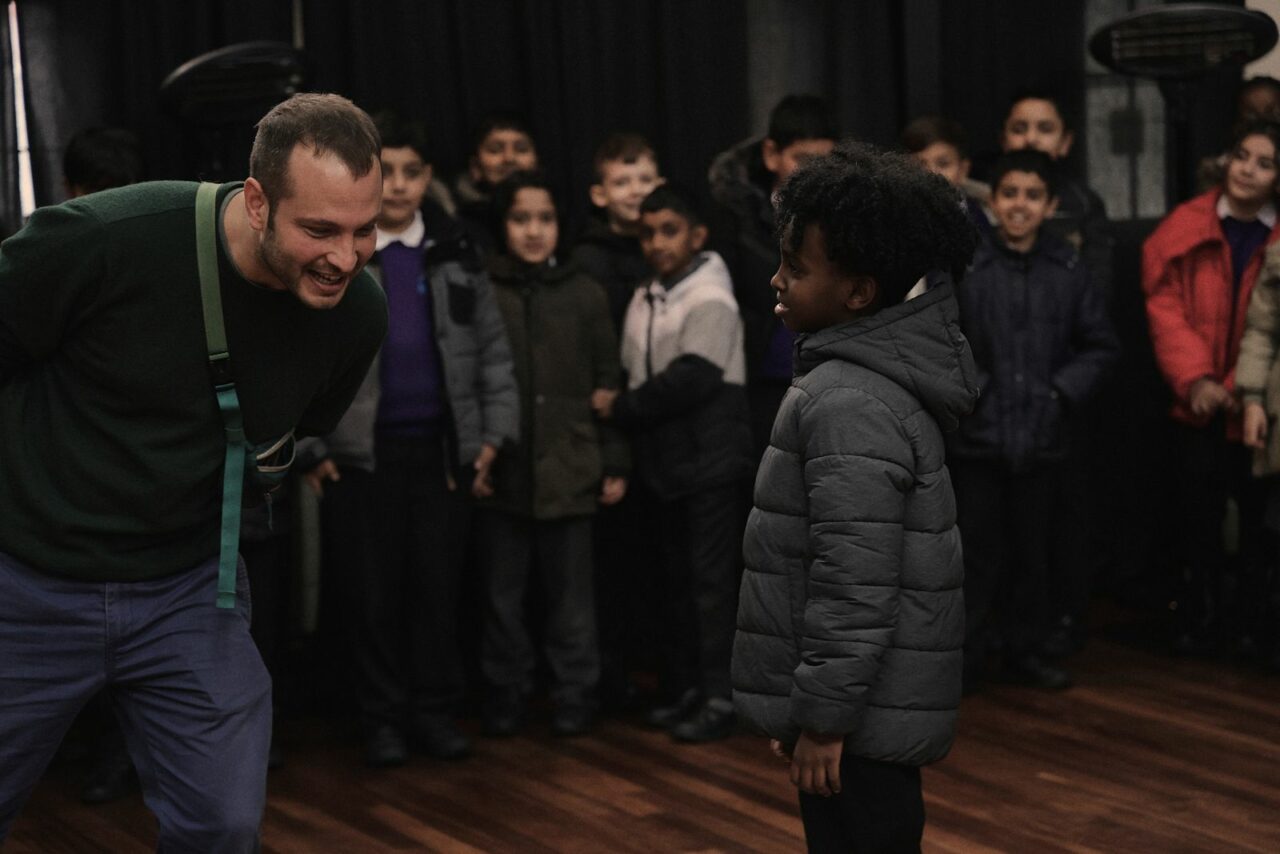
Image: Harmony of the Worlds Education Project. Photography: Anders Birger
“It makes you feel calm and good”. (Year 5 Student, Downside Primary School, Luton).
To this end, the project has developed an ongoing relationship with the NHS and Total Wellbeing Luton, which will enable the delivery of Harmony of the Worlds inspired socially prescribed sessions for people suffering from anxiety, social isolation, and long-term health conditions.
Harmony of the Worlds provides a sonic space to enable a deep sensory awareness to blossom, allowing participants to experience positive psychological states of awe and flow, and a sense of connection with themselves, their fellow listeners, and with the all-embracing ecosystem.
Recording:
The same team then recorded Essence at Abbey Road Studios. This was a landmark moment in the history of recorded sound as master engineers Mark Rogers and John Kurlander realised Satya and David’s vision of recording spatial audio with a new circular layout. This configuration deeply engaged the spatial awareness of all, each player and singer becoming acutely aware of how the listener would receive their sounds. This revolutionary approach placed the spatial nature of Essence at the creative heart of the recording process.

